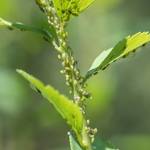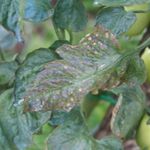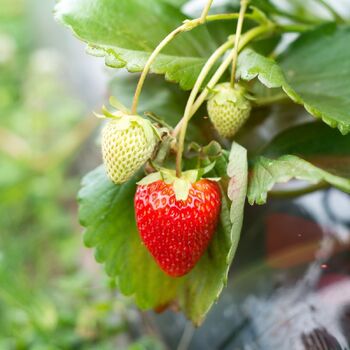
How to Grow Strawberry Runners
Grow Guide #2638
Family: Rosaceae
Binomial name: Fragaria sp.
Life Cycle: Perennial
This 'How to Grow' guide details everything a home gardener needs to know to plant, grow and care for Strawberries (Fragaria sp.).
Strawberries can also be grown from seed. To learn how to grow strawberries from seed, click here.
When to Plant Strawberry Runners
Strawberries are perennial plants that grow year round in most climates. Use the table below to identify the best time of year to plant strawberry runners in your climate.
| JAN | FEB | MAR | APR | MAY | JUN | JUL | AUG | SEP | OCT | NOV | DEC | |
|---|---|---|---|---|---|---|---|---|---|---|---|---|
| Cool | ||||||||||||
| Temperate | ||||||||||||
| Sub-Tropical | ||||||||||||
| Tropical | ||||||||||||
| Arid |
Preparation
Strawberry plants are best grown in full sun. Choose a location that will receive at least 6 hours of full sun each day.
Strawberry plants need a well drained soil enriched with plenty of organic matter. Prepare soil by weeding it thoroughly, digging it over to loosen it and adding aged animal manure or compost. Keep the area free of weeds until planting. Learn more about preparing soil for planting here. A slightly acidic soil with a pH of 5.4-6.5 is ideal for strawberries.
Strawberry plants can be grown in containers. If possible choose a variety that’s recommended for container growing. Use a good quality potting mix and make sure your container is large enough for mature plants; a minimum of 10 litres is recommended for strawberries. During the growing season, keep in mind that container grown plants may need additional fertiliser to encourage healthy growth.
How to Plant Strawberry Runners
Plant runners as soon as possible after delivery. If necessary, runners can be stored for a few days in a perforated plastic bag in the fridge prior to planting.
To prepare runners for planting, remove dead leaves and stalks and prune any roots that look dry or shrivelled.
Optional: Soak runners in water for an hour to rehydrate them prior to planting. Take care not to leave runners soaking for an extended period as this can cause them to rot.
- Space runners 30cm apart, with rows 20-30cm apart.
- Dig a 20cm deep hole and make a mound in the centre.
- Place the runner on the mound and spread the roots out evenly.
- Cover with soil, making sure the growing tip at the centre of the runner is level with the surface of the soil and not covered.
- Water in well.
- Protect runners from slugs and snails. In cold climates mulch plants or use a cloche to provide protection from frosts.
If runners had leaves these may die back after planting as plants use the nutrients in the leaves to establish roots. New leaves will grow from the crown once plants are established.
How to Grow Strawberry Plants
Strawberry plants need regular watering during the growing season. Do not let soil dry out; keep soil evenly moist but not waterlogged. Water deeply in the early morning or late afternoon. Avoid watering the leaves of plants to avoid fungal diseases. Learn more about watering here.
If soil was well prepared no extra fertiliser should be necessary. In poor soil or to give your plants an extra boost, application of a balanced fertiliser or one formulated for fruit and vegetables can be beneficial:
- Apply slow release fertiliser at the recommended rate when transplanting or when seedlings are 5-10cm tall.
- Apply liquid fertiliser at the recommended rate and frequency while plants are fruiting or flowering.
Tip: Mulch under ripening fruit with straw or sugar cane to help prevent rot.
How to Harvest Strawberries
Strawberries should be ready to harvest in approximately 140-160 days.
Starwberries are ready to harvest when they are fully coloured and fragrant. Harvest fruit by cutting with snips/secateurs or by twisting to separate from the stem. Harvest regularly to encourage more fruit. Strawberries are best eaten soon after they are harvested. Strawberries can be stored short term in a container in the fridge. For longer term storage, strawberries can be frozen or made into preserves.
Common Problems when Growing Strawberries
Like all plants, strawberry is susceptible to some pests, diseases and other problems. Below is a list of the most common problems gardeners encounter when growing strawberry plants:
 Aphids are small (2-4mm long) sap-sucking insects that congregate on the new shoots or the undersides of leaves. They can cause leaves to wilt or become discoloured, and also excrete honeydew which can attract ants and other insect pests. To manage aphids, remove them by spraying with a garden hose, apply a soap or alcohol spray, or encourage predatory insects to your garden. Read more about aphids here.
Aphids are small (2-4mm long) sap-sucking insects that congregate on the new shoots or the undersides of leaves. They can cause leaves to wilt or become discoloured, and also excrete honeydew which can attract ants and other insect pests. To manage aphids, remove them by spraying with a garden hose, apply a soap or alcohol spray, or encourage predatory insects to your garden. Read more about aphids here. Grey mould (Botrytis sp.) is a fungal disease that causes flowers to become mouldy and fruit to rot. Spores are transported by wind and can survive in soil or on green waste. The fungus spreads most in cool, damp weather. Prune off affected flowers and fruit, water plants at soil level (not on leaves) and if necessary spray with an appropriate fungicide or homemade spray.
Grey mould (Botrytis sp.) is a fungal disease that causes flowers to become mouldy and fruit to rot. Spores are transported by wind and can survive in soil or on green waste. The fungus spreads most in cool, damp weather. Prune off affected flowers and fruit, water plants at soil level (not on leaves) and if necessary spray with an appropriate fungicide or homemade spray. Armyworms, cutworms and other caterpillars can all eat the inside of fruit, making it inedible. Young caterpillars burrow into soft fruit, leaving just a small telltale hole on the fruit’s skin. Monitor fruit and remove any caterpillars you see. If necessary use insect exclusion netting or fruit bags to physically protect the fruit, or spray with Dipel.
Armyworms, cutworms and other caterpillars can all eat the inside of fruit, making it inedible. Young caterpillars burrow into soft fruit, leaving just a small telltale hole on the fruit’s skin. Monitor fruit and remove any caterpillars you see. If necessary use insect exclusion netting or fruit bags to physically protect the fruit, or spray with Dipel. Downy mildew is a fungal disease that causes yellow to grey-brown patches on leaves, especially the undersides. Water plants at soil level (not on the leaves), remove and destroy affected leaves and do not overcrowd plants to ensure adequate air flow. If problems persist, spray with a homemade milk spray or fungicide.
Downy mildew is a fungal disease that causes yellow to grey-brown patches on leaves, especially the undersides. Water plants at soil level (not on the leaves), remove and destroy affected leaves and do not overcrowd plants to ensure adequate air flow. If problems persist, spray with a homemade milk spray or fungicide. Possums, birds and other animals can ruin a large percentage of your harvest overnight. Physically exclude pests by using netting or cages, or try spraying plants with a pungent homemade spray made from garlic, fish oil or mustard.
Possums, birds and other animals can ruin a large percentage of your harvest overnight. Physically exclude pests by using netting or cages, or try spraying plants with a pungent homemade spray made from garlic, fish oil or mustard. Slugs and snails are molluscs that feed on tender leaves and shoots, mostly at night, leaving slimy trails behind them. Control them by removing their hiding places, keeping free range poultry, collecting them by torchlight or by placing traps. Read more about slugs and snails here.
Slugs and snails are molluscs that feed on tender leaves and shoots, mostly at night, leaving slimy trails behind them. Control them by removing their hiding places, keeping free range poultry, collecting them by torchlight or by placing traps. Read more about slugs and snails here.


.png)






